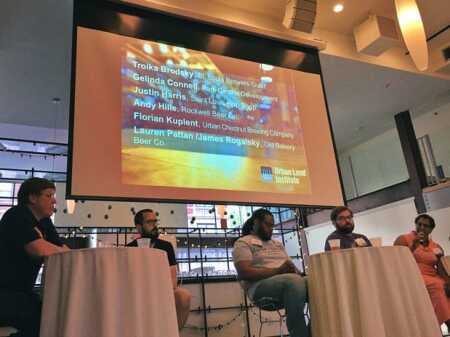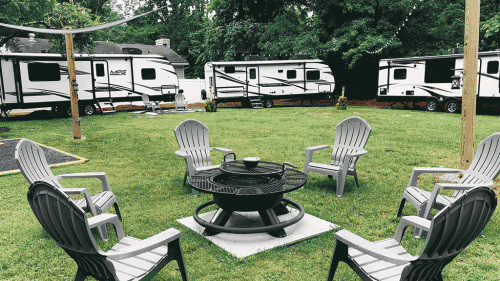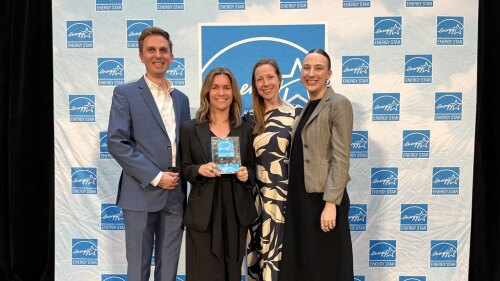
From left to right: Florian Kuplent, cofounder and brew master, Urban Chestnut Brewing Co.; James Rogalsky, founder, Old Bakery Beer Co.; Justin Harris, Saint Louis Hop Shop; Andy Hille, founder, Rockwell Beer Co.; and Gelinda Connell, project manager, Park Central Development, speaking at a ULI event in St. Louis. (Justin Foizey/ULI)
While the iconic Anheuser-Busch (AB) InBev brewery in south St. Louis is often identified with the city’s origins in beer production, smaller breweries are playing a role in revitalizing other neighborhoods. “If you drive by the brewery, you see the sign on the facade saying, ‘Come visit us,’ ” said Andy Hille, founder of Rockwell Beer Co., a craft brewery opening soon in St. Louis’s Grove neighborhood. “Brewers are selling an experience—the experience of craft beer and the neighborhoods in which they are located.”
Hille was among four St. Louis brewers who were part of a panel discussion hosted by ULI St. Louis titled “Why Every Neighborhood Needs a Brewery.” Joining the brewers on the panel was Gelinda Connell, project manager for Park Central Development, a community development corporation working to strengthen and attract investment in certain city neighborhoods. Troika Brodsky, executive director of the St. Louis Brewer’s Guild, led the discussion and added his insights.
There was a time before Prohibition when St. Louis had more than 40 breweries. By the 1980s, however, that number had dwindled to just two, including the world’s largest brewer, Anheuser-Busch. When AB sold to InBev in 2008, the foundation of the city’s beer culture shifted. Brewmasters and beer drinkers began to seek something different, something that still belonged to the local community. Today, Brodsky said that St. Louis’s beer scene is again thriving, with 50 separate breweries operating locally. Among them is Urban Chestnut Brewing Co., led by Florian Kuplent, a former AB brewmaster. Urban Chestnut opened in St. Louis in 2010 and, by 2014, was ready for a second location with greater capacity.
“When looking for our second location—one that would serve as our new primary production facility—we knew we needed to be in the city, close to the center,” Kuplent said. “Our location in the Grove positions us to distribute more efficiently and still be a part of a growing neighborhood.”
Urban Chestnut’s breweries have energized two neighborhoods on the upswing, providing a social anchor in the midst of emerging commercial corridors.
“You see a lot of construction in the Grove since the opening of Urban Chestnut,” Connell noted . “The growth has been organic, but the breweries add energy by drawing visitors and helping to strengthen existing businesses as they build distribution networks with restaurants.”
Like Urban Chestnut, Rockwell Beer Co. sees great promise in the Grove neighborhood.
“It’s really cool to be part of community building,” Hille said. “Beer can be a catalyst—the neighborhood comes together to connect over a beer, friendships form, and community builds. You become distinctive part of the neighborhood.” He also noted the pride that people feel in their local breweries, evidenced by the proliferation of T-shirts emblazoned with brewery logos. Beer lovers are not only sharing their love of the brew but also connecting with the community the brewer serves.
“Breweries serve as community centers where people connect and create vibrant neighborhoods,” Brodsky said. “It’s more than just, ‘Stop by for a beer.’ It’s ‘Stop, sip, and stay.’ ”
And, as noted, breweries often serve as training grounds for young brewers who seize opportunities to branch out into other neighborhoods across the region. James Rogalsky, an Urban Chestnut alum, now owns Old Bakery Beer Co. with fellow alum Lauren Pattan. Rogalsky looked at several sites in south St. Louis, but he found the upfront real estate investment in the city too high. In broadening his property search, Rogalsky rediscovered his nearby hometown of Alton, Illinois, where the property values were more manageable. Today, he is brewing in an 1800s-era bakery building and is distributing his Old Bakery beers across the region.
“We have about 10,000 square feet [929 sq m] for the brewery and 6,000 square feet [557 sq m] for our restaurant and event space,” Rogalsky said. “In Alton, our brewery is kind of on an island, surrounded by vacant lots. If we can help turn the city around, that would be great.”
Nearby on Cherokee Street, Justin Harris and his brother opened the St. Louis Hop Shop in 2015. Born out of a love of discovering new beers, the store allows purchasers to buy single bottles from a variety of brewers, instead of committing to a six-pack. A big part of Hop Shop’s vision is to connect the community by providing good beer and participating in festivals, tastings, and happy hours.
“I really like investing in the city,” Harris said. “I was born and raised in the city, so I really want to be part of revitalizing it.”
It appears that even with another ten craft breweries slated to open in St. Louis in the coming months, the metro area is far from saturated. “I’m not threatened by competition,” Hille said. “The more people who come to our neighborhood for the beer, the better it is for all of us.”
With craft brewers spurring additional commercial development, many wonder whether residential development will soon follow. In some instances, particularly in the Grove, the residential market has strengthened as the breweries have gained traction. In other areas, the brewers are the early pioneers and the neighborhood is taking more of a wait-and-see approach. At least that is what some think when driving through. The real estate developers in St. Louis, however, may know better.





